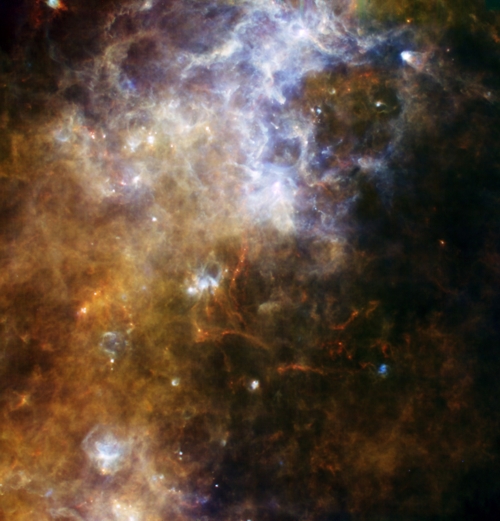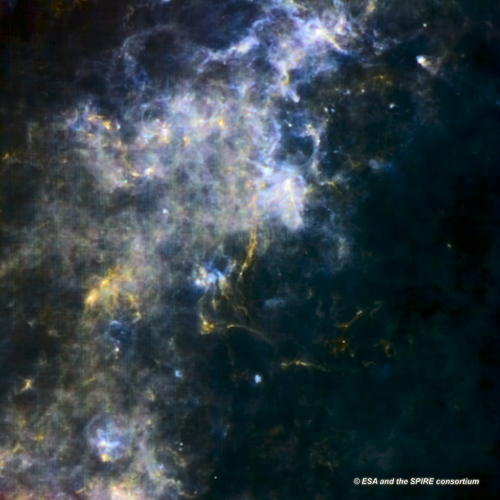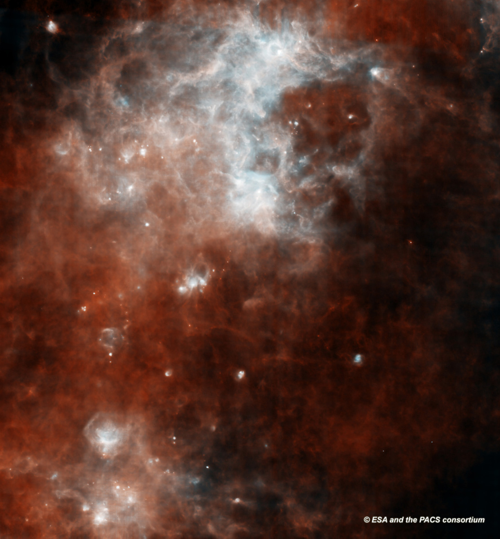Spectacular new images of interstellar material in our galaxy have been produced, using the UK-led SPIRE camera in tandem with Herschel’s other camera, PACS.
The new pictures, made during the first trial run with the two instruments operating at the same time, have unveiled a small part of our Milky Way Galaxy as we have never seen it before, and bode well for one of Herschel’s main scientific projects, which is to survey large areas of the galaxy.

Professor Matt Griffin of Cardiff University, who is the SPIRE Principal Investigator, said: “We had high hopes for this kind of observation with Herschel, using the combined power of the two cameras to see the galaxy as never before. It’s great to see that the observations work so well from a technical point of view, and that the scientific results are so spectacular. It appears that star formation in the galaxy is a very turbulent process.”
The SPIRE camera responds to light at wavelengths between 250 and 500 microns (millionths of a metre) – 500-1000 times longer than the wavelength of visible light – and PACS covers wavelengths between 70 and 170 microns. Together they provide detailed images in five different far infrared colours, not only revealing new material in the Galaxy, but providing astronomers with a wealth of information about it – such as how much material there is, its mass, temperature and composition, and whether or not some of it is collapsing to form new stars. Stars form in cold, dense environments, and the composite images locate the star-forming regions that would be very difficult to isolate from a map made at a single far-infrared or submillimetre wavelength.
Professor Derek Ward-Thompson, also of Cardiff University, said: “The wealth of detail that is visible in these images is quite simply stunning. We are getting a view of the interstellar medium such as we have never seen before. This will help us to unravel the mysteries of star formation in a way that has never been previously possible. Herschel is certainly living up to all of our expectations.”
The two instruments have imaged an area of about 2 x 2 degrees (about 16 times as big as the size of the Moon as seen from Earth), revealing an extremely rich reservoir of cold material in the Galactic Plane which is seen to be in a previously unsuspected state of turmoil. The interstellar material is condensing in a continuous and interconnected maze of filaments and strings of newly forming stars in all stages of development, unveiling a tireless Galaxy constantly forging new generations of stars. We see an intricate network of filamentary structures with surprising features indicative of a chain of near-simultaneous star-formation events, glittering rather like beads of water on a string in the sunlight.
Large areas of the Milky Way will be systematically surveyed by Herschel in this manner, helping astronomers to unravel the mysteries of star formation in a way that has never been previously possible. With the two instruments operating at the same time, the observations can be made with great efficiency.
Dr David Clements from the SPIRE team at Imperial College London’s Department of Physics added: “These images show SPIRE and PACS working together in perfect harmony, something that will be needed not only for studies of our own galaxy but also for Herschel’s large UK-led studies of galaxy evolution. It also demonstrates the UK’s instrumentation expertise for future far-IR space missions.”
Dr Pete Hargrave, who led the Cardiff team that helped build the SPIRE instrument, said: “I am staggered by the beauty of these images. We can see, in exquisite detail, the material from which stars are born. The fact that SPIRE and PACS are working so well together is testament to the expertise and years of hard work put in by both instrument teams. We’re all pretty chuffed!”


